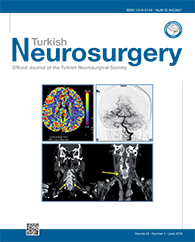2Baskent University, Faculty of Medicine, Department of Pathology, Ankara, Turkey
3Gelisim Hospital, Neurosurgery Clinic, Iskenderun, Hatay, Turkey DOI : 10.5137/1019-5149.JTN.14781-15.3 AIM: Delayed ischemic neurological deficit (DIND) and cerebral vasospasm (CV) remain the most common and debilitating neurological complications following aneurysmal subarachnoidal hemorrhage (SAH). Many reports demonstrate the importance of proanthocyanidins (PR) on the vascular system, including endothelium-dependent relaxation of blood vessels. These effects of PR on the cerebral vascular system were examined in this study.
RESULTS: There were significant differences between the groups except control and pre-SAH (p=0.37) and post-SAH and pre- SAH groups (p=0.15) with respect to BAD. According to arterial wall thickness, apoptosis ratio, and grading, there were significant differences between the groups except control and pre-SAH (p=0.85, p=0.49 and p=0.18 respectively) and SAH and post-SAH (p=0.08, p=0.21 and p=0.24 respectively) groups. EM findings revealed that pro-apoptotic and pro-necrotic degenerated endothelial cells with seldom vacuolization in post-SAH treatment group which were more serious in SAH group.
CONCLUSION: Pre-SAH administration of PR induces better vasodilatation and protection of basilar artery (BA) from vasospasm (VS), which could yield neuroprotective and vasodilatator effects. In addition, PR appears to be involved in relieving oxidative damage, with an antioxidant-antiapoptotic-antinecrotic effect that may contribute to vascular dilation.





